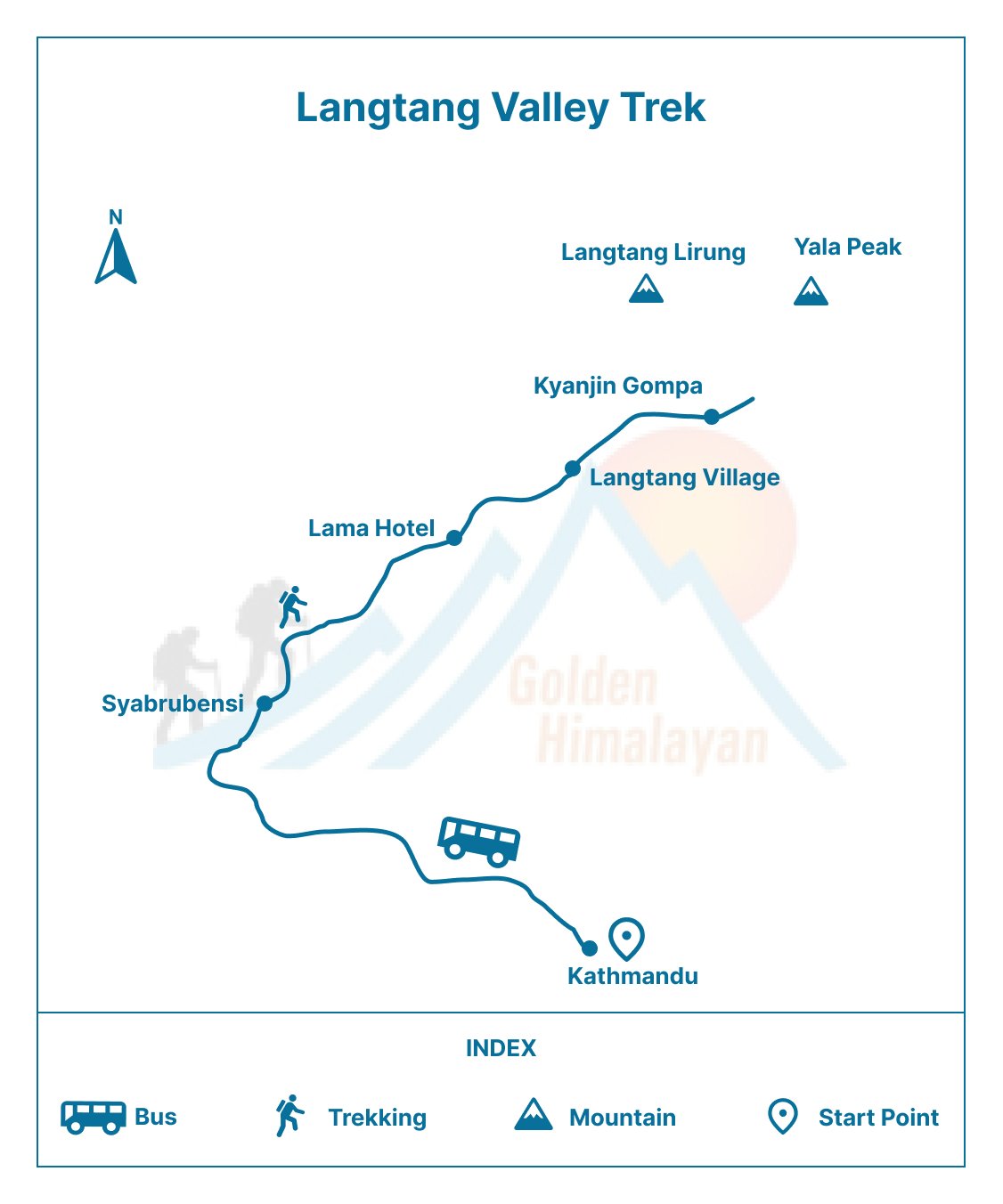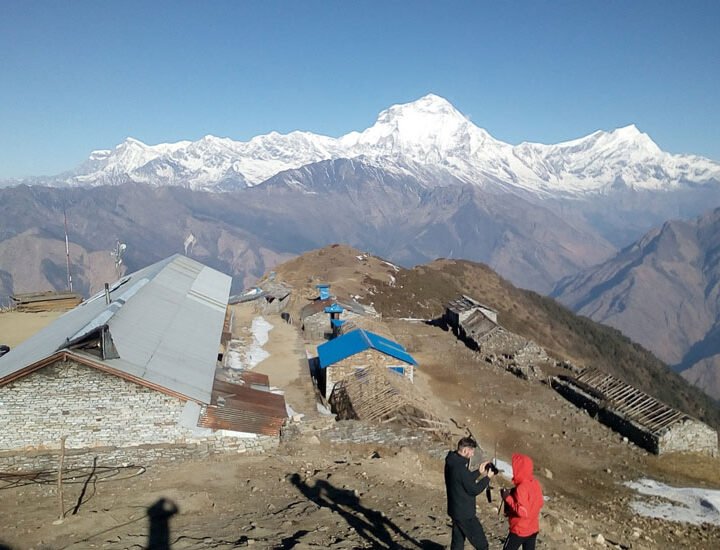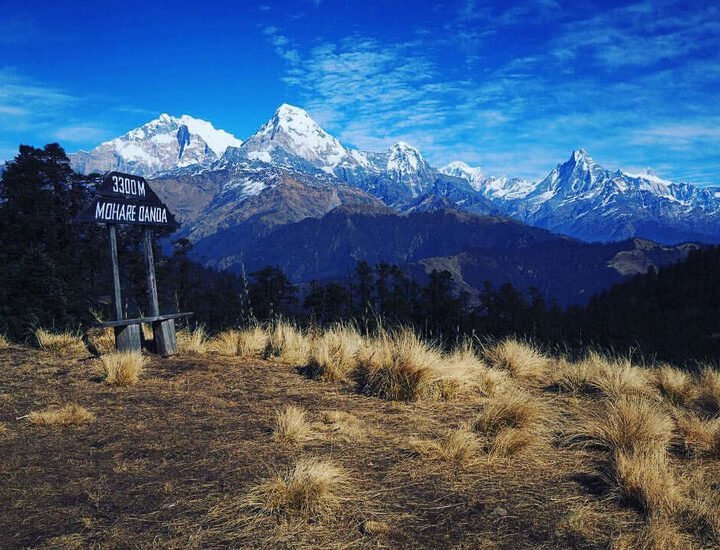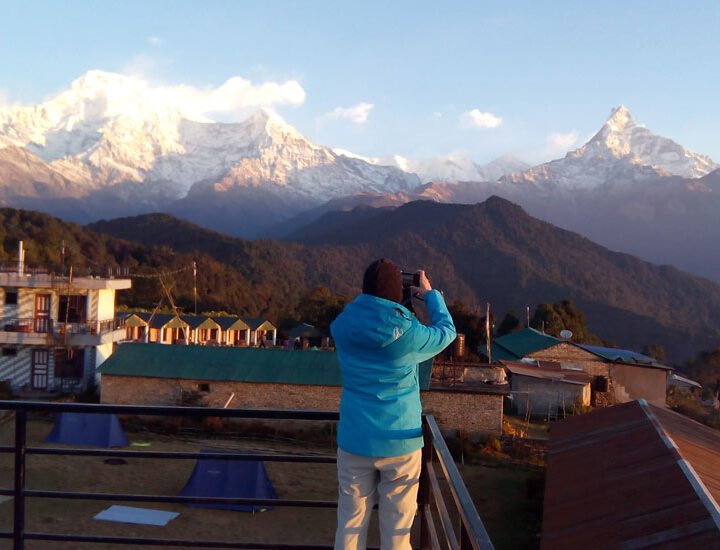- Details
Detailed itinerary
Itinerary- Tour Includes/Excludes
- Useful Info
- Map
- FAQ
Trip overview
Overshadowed by the mostly talked trekking routes like Annapurna Base Camp and Everest Base Camp Trek, Langtang Valley is a gem and a gifted location that most of the people miss. Langtang valley is also known as the valley of glaciers. With majestic views of the Langtang Himalayas, the short trekking route goes through rhododendron forests and various rivers and waterfalls.Also, the cultural beauty of the Tamang and Sherpa people living in this region remains a major highlight of the trek.
The trek is nine days long. In these nine days, you will trek through stunning villages like theLangtang village. The trip starts from Kathmandu with some sightseeing and strolling around the city. You will be accommodated at a beautiful luxurious hotel for the night. On the next morning, we drive to Syabrubensi.Enjoy the views of lush green hills on the way to Syabrubensi.
From Syabrubensi, you will hike up to Lama Hotel and spend a night there. The next morning, you trek to Langtang village and enjoy the rich culture of the Tamang people living there. Before returning to Syabrubensi, you will hike to Kyanjin Gompa, and then trek down to Lama Hotel.Along the trail, you can see the beautiful view of mountains like Dorje Lakpa (6,990m), Langtang Ri (6,370m), and Langtang Lirung (7,245m).
For this trek, the weather is more stable and predictable during March-June (spring) and September-November (autumn). Hence, we recommend you travel to this region during spring or autumn. Since it is a short trek and well-trained guides take you through the trek, beginners can also join the trek.
Travel with Golden Himalayan Zone to get the best timely services of transportation and accommodation during your travel. You can customize your itinerary and extend or shorten the trek duration. We provide well-trained guides and porters to make your trip stress-free.
Trip Highlights:
- Trek through Langtang valley, also known as the valley of glaciers.
- Discover Tibetan Buddhist culture and local tradition
- Walk along with beautiful rhododendron forests, gushing rivers, and spectacular waterfalls.
- Interact with the locals and stay at teahouses run by the locals.
Itinerary
After your arrival, you will be attended by our staff and escorted to the center of the city, a place called Thamel. At Thamel, you will be taken to your hotel where you will spend the night while our staffs prepare you for the trek. You will be briefed about the trek the same day.
After having breakfast at Thamel, you will leave for Syabrubensi (1,460m) by bus. It’s a 6-7 hour drive from Kathmandu. On the way, you pass by various beautiful villages along the beautiful Trishuli River. You will see beautiful hills and forests on the way to Syabrubensi. Syabrubensi is the starting point of the trek. You will stay overnight at a lodge in Syabrubensi.
After a comfortable night stay and breakfast at Syabrubensi, your trek starts as you ascend uphill through the forests. On the way to Lama Hotel (2,560m), you get to see mesmerizing scenes of mountains, rhododendron forests, and wildlife. You walk through bamboo forests and hills. After trekking for about 6 to 7 hours, you reach the Lama Hotel. Overnight at Lama Hotel.
After breakfast at Lama Hotel, we ascend towards Langtang Village. On the way to Langtang village, you can encounter various wildlife of this region. For most of the part, you walk through the Langtang National Park today. You will get to catch glimpses ofgorals, boars, and red panda if lucky.You can stop at various places and enjoy the natural beauty of the Langtang region. You will also observe the culture of the Tamang people living in Langtang Village.At the end of the day, you spend the night at Langtang Village interacting with the local Tamang people.
On the fifth day of the trek, you reach the maximum height during the whole trek. It's a 5-6 hours walk. You reach an altitude of 3,870m, which is the highest in this trek. You ascend from Langtang Village to Kyanjin Gompa. The old gompas here are very important to the local Tamangs and Sherpas. You walk through villages and monasteries listening to Buddhist prayers. You spend the night here at Kyanjin Gompa before descending to Langtang Village the next morning.
This part of the trek is longest in terms of distance covered. But since it is a gradual descending trek, it is relatively more relaxed compared to previous days. You will walk for 6-7 hours. On the way back to Lama Hotel, you will see streams and rhododendron forests. You could also encounter wildlife you missed while ascending. You spend the night at Lama Hotel.
After breakfast at Lama Hotel, you slowly descend back to Syabrubensi at your desired speed. You can rest and take photographs while descending. You get to catch up with the things you missed while ascending the route.Overnight at Syabrubensi.
After breakfast at Syabrubensi, you drive back to Kathmandu. The drive is usually 6 to 7 hours long. The staff will take you back to the hotel for dinner. Overnight at the hotel in Thamel.
This is the day you depart. Before you leave, let us know your feedback on the trip. Our staff will make sure that you reach the airport on time.
Included
- Trekking permits: The Langtang National Park entry permit and the TIMS (Trekkers’ Information Management System) card are required for the trek, and their costs are typically included in the package.
- Accommodation: Accommodation during the trek is typically included in the package. Tea houses or lodges along the trail provide basic but comfortable accommodation, and some packages may include the cost of a sleeping bag if needed.
- Food: Most packages include meals (breakfast, lunch, and dinner) during the trek. The food served is usually a mix of local and international cuisines.
- Guide and porter: Hiring a guide and porter is highly recommended for the Langtang Valley Trek, and their costs are usually included in the package. A guide can provide valuable information about the local culture, history, and geography of the region, while a porter can carry your backpack and other gear, allowing you to trek with more ease.
Excluded
- Flights: The cost of flights to and from Kathmandu is typically not included in the package, and you will need to book these separately.
- Travel insurance: Travel insurance is essential for any trekking in Nepal, and the cost of this is usually not included in the package.
- Additional services: Additional services such as airport transfers, sightseeing tours, and extra nights in Kathmandu are not typically included in the package.
- Tips: It's customary to tip the guide and porter at the end of the trek, and this cost is not typically included in the package.
Useful Info
- Trekking permits: As mentioned earlier, you will need to obtain a Langtang National Park entry permit and a TIMS card to trek in the Langtang region. These permits can be obtained at the Nepal Tourism Board in Kathmandu or from the checkpoint in Syabrubesi.
- Altitude sickness: The Langtang Valley Trek involves gaining altitude gradually, but it's still important to be aware of altitude sickness. Symptoms include headache, nausea, dizziness, and shortness of breath. It's recommended to acclimatize properly and take rest days to avoid altitude sickness.
- Weather and temperature: The weather in the Langtang region can be unpredictable, so it's important to pack for different weather conditions. The temperature can vary from warm during the day to freezing at night, especially at higher altitudes.
- Accommodation: Tea houses or lodges along the trail provide basic but comfortable accommodation. The lodges have shared rooms and bathrooms, and some may not have hot water or electricity. It's recommended to bring a sleeping bag for added warmth.
- Food and water: The lodges along the trail serve a variety of local and international cuisines. It's recommended to avoid meat and dairy products to minimize the risk of foodborne illnesses. It's also important to drink plenty of water and carry a water purification system or tablets to purify water from natural sources.
- Gear and equipment: It's important to bring the right gear and equipment for the trek. This includes trekking shoes, warm clothes, a hat, gloves, a backpack, a sleeping bag, and a trekking pole. It's also recommended to bring a first aid kit and a good-quality camera to capture the stunning views.
- Guides and porters: Hiring a guide and porter is highly recommended for the Langtang Valley Trek. A guide can provide valuable information about the local culture and geography, while a porter can carry your backpack and other gear, allowing you to trek with more ease.
FAQs
-
How difficult is the Langtang Valley Trek?
The Langtang Valley Trek is a moderate trek that can be done by people with a good level of fitness. The trek involves walking for 6-7 hours per day on average, with some steep and rocky sections. Acclimatization days and rest days are also built into the trek to help with altitude adaptation.
-
How long does the Langtang Valley Trek take?
The Langtang Valley Trek usually takes 9-12 days, depending on the route taken and the pace of the trekker. Some trekking companies also offer shorter or longer itineraries based on the trekker's preferences.
-
What is the best time to do the Langtang Valley Trek?
The best time to do the Langtang Valley Trek is from mid-September to mid-December, and from mid-February to May. During these months, the weather is dry and stable, and the skies are generally clear, providing great visibility of the stunning mountain views.
-
Do I need a guide for the Langtang Valley Trek?
While it's not mandatory to have a guide for the Langtang Valley Trek, it's highly recommended. A guide can provide valuable information about the local culture, history, and geography of the region, as well as help with logistics and safety.
-
Is it safe to trek in the Langtang Valley?
The Langtang Valley Trek is generally considered safe, but it's important to take precautions and be aware of potential risks. Altitude sickness, unpredictable weather, and natural hazards such as landslides and avalanches are some of the potential risks to be aware of. Hiring a guide and porter, following safety guidelines, and being prepared with the right gear and equipment can help mitigate these risks.
-
Can I use credit cards or ATMs during the Langtang Valley Trek?
Credit cards and ATMs are not available along the trekking route, so it's recommended to bring enough cash for the trek. It's also advisable to exchange the currency in Kathmandu before starting the trek.
-
Do I need travel insurance for the Langtang Valley Trek?
Travel insurance is highly recommended for the Langtang Valley Trek. The insurance should cover emergency medical treatment, medical evacuation, trip cancellation, and other potential risks associated with trekking in a remote mountain region.







